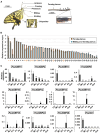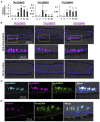Coexpression of Three Odorant-Binding Protein Genes in the Foreleg Gustatory Sensilla of Swallowtail Butterfly Visualized by Multicolor FISH Analysis
- PMID: 38468877
- PMCID: PMC10926539
- DOI: 10.3389/finsc.2021.696179
Coexpression of Three Odorant-Binding Protein Genes in the Foreleg Gustatory Sensilla of Swallowtail Butterfly Visualized by Multicolor FISH Analysis
Abstract
Lepidopteran insects are mostly monophagous or oligophagous. Female butterflies distinguish their host plants by detecting a combination of specific phytochemicals through the gustatory sensilla densely distributed on their foreleg tarsi, thereby ensuring oviposition on appropriate host plants. In this study, to gain insight into the molecular mechanism underlying host plant recognition by the gustatory sensilla, using Asian swallowtail, Papilio xuthus, we focused on a family of small soluble ligand-binding molecules, odorant-binding proteins (OBPs), and found that three OBP genes showed enriched expression in the foreleg tarsus. Multicolor fluorescence in situ hybridization analyses demonstrated the coexpression of these three OBP genes at the bases of the foreleg gustatory sensilla. Further analyses on other appendages revealed that PxutOBP3 was exclusively expressed in the tissues which could have direct contact with the leaf surface, suggesting that this OBP gene specifically plays an important role in phytochemicals perception.
Keywords: Papilio xuthus; butterfly; fluorescence in situ hybridization; gustatory sensilla; host plant selection; odorant-binding protein.
Copyright © 2021 Ugajin and Ozaki.
Conflict of interest statement
The authors declare that the research was conducted in the absence of any commercial or financial relationships that could be construed as a potential conflict of interest.
Figures






Similar articles
-
A gustatory receptor involved in host plant recognition for oviposition of a swallowtail butterfly.Nat Commun. 2011 Nov 15;2:542. doi: 10.1038/ncomms1548. Nat Commun. 2011. PMID: 22086342
-
Identification and genomic structure of chemosensory proteins (CSP) and odorant binding proteins (OBP) genes expressed in foreleg tarsi of the swallowtail butterfly Papilio xuthus.Insect Biochem Mol Biol. 2008 Nov;38(11):969-76. doi: 10.1016/j.ibmb.2008.07.010. Epub 2008 Aug 14. Insect Biochem Mol Biol. 2008. PMID: 18771731
-
Gustatory sensing mechanism coding for multiple oviposition stimulants in the swallowtail butterfly, Papilio xuthus.J Neurosci. 2013 Jan 16;33(3):914-24. doi: 10.1523/JNEUROSCI.1405-12.2013. J Neurosci. 2013. PMID: 23325231 Free PMC article.
-
Identification of amine receptors from a swallowtail butterfly, Papilio xuthus L.: cloning and mRNA localization in foreleg chemosensory organ for recognition of host plants.Insect Biochem Mol Biol. 2004 Dec;34(12):1247-56. doi: 10.1016/j.ibmb.2004.08.009. Insect Biochem Mol Biol. 2004. PMID: 15544938
-
Identification of cytochrome P450 and glutathione-S-transferase genes preferentially expressed in chemosensory organs of the swallowtail butterfly, Papilio xuthus L.Insect Biochem Mol Biol. 2005 Aug;35(8):837-46. doi: 10.1016/j.ibmb.2005.03.013. Insect Biochem Mol Biol. 2005. PMID: 15944080
Cited by
-
Identification of an additional periplanone receptor family gene preferentially expressed in the male antennae of the American cockroach.Sci Rep. 2025 Jan 31;15(1):3949. doi: 10.1038/s41598-025-87978-6. Sci Rep. 2025. PMID: 39890892 Free PMC article.
References
LinkOut - more resources
Full Text Sources

